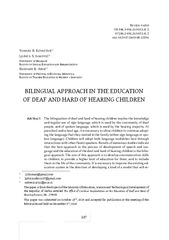Приказ основних података о документу
Bilingual approach in the education of deaf and hard of hearing children
Biligvalni pristup u obrazovanju gluve i nagluve dece
| dc.creator | Kovačević, Tamara | |
| dc.creator | Isaković, Ljubica | |
| dc.creator | Arsić, Radomir | |
| dc.date.accessioned | 2021-06-09T14:30:29Z | |
| dc.date.available | 2021-06-09T14:30:29Z | |
| dc.date.issued | 2019 | |
| dc.identifier.issn | 0354-3293 | |
| dc.identifier.uri | http://rfasper.fasper.bg.ac.rs/handle/123456789/1244 | |
| dc.description.abstract | The bilingualism of deaf and hard of hearing children implies the knowledge and regular use of sign language, which is used by the community of deaf people, and of spoken language, which is used by the hearing majority. At preschool and school age, it is necessary to allow children to continue adopting the language that they started in the family (either sign language or spoken language). Children will adopt both language modalities best through interactions with other fluent speakers. Results of numerous studies indicate that the best approach in the process of development of speech and language and the education of the deaf and hard of hearing children is the bilingual approach. The aim of this approach is to develop communication skills in children, to provide a higher level of education for them, and to include them in the life of the community. It is necessary to improve the existing education system in the direction of developing a kind of a model that will respond to their specificities and limitations caused by their primary impairment. | en |
| dc.description.abstract | Bilingvizam gluve i nagluve dece podrazumeva poznavanje i redovnu upotrebu znakovnog jezika, koji koristi zajednica gluvih i govornog jezika koji koristi čujuća većina. Na predškolskom i školskom uzrastu, potrebno je omogućiti deci da nastave da usvajaju jezik koja su počela da usvajaju u porodici (znakovni ili govorni). Deca će najbolje usvojiti oba jezička modaliteta kroz interakcije sa drugim fluentnim govornicima. Rezultati mnogobrojnih istraživanja ukazuju da je najbolji pristup u procesu razvoja govora i jezika i obrazovanju gluve i nagluve dece - bilingvalni pristup. Cilj ovog pristupa je razviti komunikacijske veštine kod dece, omogućiti im viši nivo obrazovanja i uključiti ih u život društvene zajednice. Neophodno je usavršavanje postojećeg obrazovnog sistema u pravcu razvijanja takvog modela koji će da odgovori na njihove specifičnosti i ograničenja uzrokovana njihovim primarnim oštećenjem. | sr |
| dc.publisher | Univerzitet u Prištini - Filozofski fakultet, Kosovska Mitrovica | |
| dc.relation | info:eu-repo/grantAgreement/MESTD/Basic Research (BR or ON)/179055/RS// | |
| dc.rights | openAccess | |
| dc.rights | openAccess | |
| dc.rights.uri | https://creativecommons.org/licenses/by-nc/4.0/ | |
| dc.source | Zbornik radova Filozofskog fakulteta u Prištini | |
| dc.subject | bilingual approach | en |
| dc.subject | education | en |
| dc.subject | deaf and hard of hearing children | en |
| dc.subject | bilingvalni pristup | sr |
| dc.subject | obrazovanje | sr |
| dc.subject | gluva i nagluva deca | sr |
| dc.title | Bilingual approach in the education of deaf and hard of hearing children | en |
| dc.title | Biligvalni pristup u obrazovanju gluve i nagluve dece | sr |
| dc.type | article | |
| dc.rights.license | BY-NC | |
| dc.rights.license | BY-SA | |
| dc.citation.epage | 124 | |
| dc.citation.issue | 4 | |
| dc.citation.other | 49(4): 107-124 | |
| dc.citation.rank | M24 | |
| dc.citation.spage | 107 | |
| dc.citation.volume | 49 | |
| dc.identifier.doi | 10.5937/ZRFFP49-23596 | |
| dc.identifier.fulltext | http://rfasper.fasper.bg.ac.rs/bitstream/id/210/1241.pdf | |
| dc.type.version | publishedVersion | |
| dc.type.version | publishedVersion |


